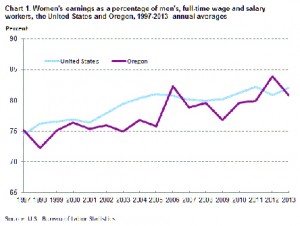In 2013, Oregon women who were full-time wage and salary workers had median usual weekly earnings of $705, or 80.8 percent of the $873 median usual weekly earnings for their male counterparts, the U.S. Bureau of Labor Statistics reported today.
Regional Commissioner Richard J. Holden noted that the women’s to men’s earnings ratio in Oregon decreased 3.1 percentage points from the previous year. Nationwide, women earned $706 per week, or 82.1 percent of the $860 median for men. (See table 1. Earnings in this report do not control for many factors that can be significant in explaining earnings differences.)
In Oregon, the ratio of women’s to men’s earnings has ranged from a low of 72.2 percent in 1998 to a high of 83.9 percent in 2012. The current year marked the first decrease in the ratio in Oregon since 2009. (See chart 1. Data for the states began in 1997.)
Among the 50 states, median weekly earnings of women in full-time wage and salary positions in 2013 ranged from $591 in Louisiana and Oklahoma to $900 in Massachusetts. States with the highest wages for women were located along the Eastern Seaboard. In addition to Massachusetts, women’s earnings in Connecticut, Maryland, and Virginia were above $800 per week. In the District of Columbia, women earned a median weekly wage of $1,100.
Median weekly earnings for men were lowest in Arkansas at $705 and highest in Massachusetts at $1,109. Three other states (Connecticut, Alaska, and Maryland) had weekly wages above $1,000 for full-time male workers. In the District of Columbia, men earned a median weekly wage of $1,212.
Vermont had the highest female-to-male earnings ratio among the states, 91.3 percent, and Wyoming had the lowest, 68.6 percent. The District of Columbia had a ratio of 90.8 percent.. The differences among the states reflect, in part, variation in the occupations and industries found in each state and in the age composition of each state’s labor force. In addition, comparisons by gender are on a broad level and do not control for factors such as educational attainment which can be significant in explaining earnings differences.
Technical Note
The estimates in this release were obtained from the Current Population Survey (CPS), which provides information on the labor force, employment, and unemployment. This survey is conducted monthly for the Bureau of Labor Statistics (BLS) by the U.S. Census Bureau, using a scientifically selected national sample of about 60,000 eligible households, representing all 50 states and the District of Columbia. The earnings data are collected from one-fourth of the CPS monthly sample and are limited to wage and salary workers. All self-employed workers, both incorporated and unincorporated, are excluded from the data presented in this report.
Statistics based on the CPS data are subject to both sampling and nonsampling error. The differences among data for the states reflect, in part, variation in the occupations and industries found in each state and diversity in the age composition of each state’s labor force. In general, the sampling error for the state estimates is considerably larger than it is for the national data; thus, comparisons of state estimates should be made with caution.
The principal concepts and definitions used in connection with the earnings data in this release are described briefly below.
Usual weekly earnings. The data represent earnings before taxes and other deductions and include any overtime pay, commissions, or tips usually received (at the main job in the case of multiple jobholders). Respondents are asked to identify the easiest way for them to report earnings (hourly, weekly, biweekly, twice monthly, monthly, annually, or other) and how much they usually earn in the reported time period. Earnings reported on a basis other than weekly are converted to a weekly equivalent. The term “usual” is determined by each respondent’s own understanding of the term.
Medians of usual weekly earnings. The earnings estimates shown in this release are medians. The median is the midpoint in a given earnings distribution, with half of workers having earnings above the median and the other half having earnings below the median.
Wage and salary workers. These are workers age 16 and older who receive wages, salaries, commissions, tips, payments in kind, or piece rates on their sole or principal job. This group includes employees in both the public and private sectors. All self-employed workers are excluded whether or not their businesses are incorporated.
Full-time worker. People who usually work 35 hours or more per week at their sole or principal job are defined as working full time for the purpose of these estimates.
For more information on the median weekly earnings of women and men, see Bureau of Labor Statistics Report 1051, Highlights of Women’s Earnings in 2013, available Here.
.
Information in this release will be available to sensory impaired individuals upon request: 202-691-5200;
Federal Relay Service: 1-800-877-8339.





